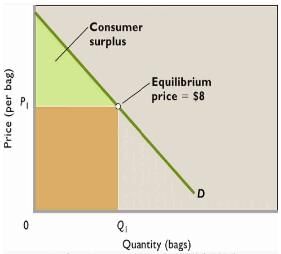Class 11 Exam > Class 11 Questions > Explain producer equilibrium in single and do...
Start Learning for Free
Explain producer equilibrium in single and double commodity with diagram.?
Verified Answer
Explain producer equilibrium in single and double commodity with diagr...
The term ‘equilibrium’ is frequently used in economic analysis. Equilibrium means a state of rest or a position of no change. It refers to a position of rest, which provides the maximum benefit or gain under a given situation. A consumer is said to be in equilibrium, when he does not intend to change his level of consumption, i.e., when he derives maximum satisfaction.
Consumer’s Equilibrium refers to the situation when a consumer is having maximum satisfaction with limited income and has no tendency to change his way of existing expenditure. The consumer has to pay a price for each unit of the commodity. So, he cannot buy or consume unlimited quantity. As per the Law of DMU, utility derived from each successive unit goes on decreasing. At the same time, his income also decreases with purchase of more and more units of a commodity.
So, a rational consumer aims to balance his expenditure in such a manner, so that he gets maximum satisfaction with minimum expenditure. When he does so, he is said to be in equilibrium. After reaching the point of equilibrium, there is no further incentive to make any change in the quantity of the commodity purchased.
It is assumed that the consumer knows the different goods on which his income can be spent and the utility that he is likely to get out of such consumption. It means that the consumer has perfect knowledge of the various choices available to him.

 This question is part of UPSC exam. View all Class 11 courses
This question is part of UPSC exam. View all Class 11 courses

|
Explore Courses for Class 11 exam
|

|
Similar Class 11 Doubts
Explain producer equilibrium in single and double commodity with diagram.?
Question Description
Explain producer equilibrium in single and double commodity with diagram.? for Class 11 2024 is part of Class 11 preparation. The Question and answers have been prepared according to the Class 11 exam syllabus. Information about Explain producer equilibrium in single and double commodity with diagram.? covers all topics & solutions for Class 11 2024 Exam. Find important definitions, questions, meanings, examples, exercises and tests below for Explain producer equilibrium in single and double commodity with diagram.?.
Explain producer equilibrium in single and double commodity with diagram.? for Class 11 2024 is part of Class 11 preparation. The Question and answers have been prepared according to the Class 11 exam syllabus. Information about Explain producer equilibrium in single and double commodity with diagram.? covers all topics & solutions for Class 11 2024 Exam. Find important definitions, questions, meanings, examples, exercises and tests below for Explain producer equilibrium in single and double commodity with diagram.?.
Solutions for Explain producer equilibrium in single and double commodity with diagram.? in English & in Hindi are available as part of our courses for Class 11.
Download more important topics, notes, lectures and mock test series for Class 11 Exam by signing up for free.
Here you can find the meaning of Explain producer equilibrium in single and double commodity with diagram.? defined & explained in the simplest way possible. Besides giving the explanation of
Explain producer equilibrium in single and double commodity with diagram.?, a detailed solution for Explain producer equilibrium in single and double commodity with diagram.? has been provided alongside types of Explain producer equilibrium in single and double commodity with diagram.? theory, EduRev gives you an
ample number of questions to practice Explain producer equilibrium in single and double commodity with diagram.? tests, examples and also practice Class 11 tests.

|
Explore Courses for Class 11 exam
|

|
Suggested Free Tests
Signup for Free!
Signup to see your scores go up within 7 days! Learn & Practice with 1000+ FREE Notes, Videos & Tests.
























